This is an explanation of the second logic game from Section III of LSAT 70, the October 2013 LSAT.
A corporate manager is choosing at least four employees to place on a research team. The manager can choose from the following employees: Myers, Ortega, Paine, Schmidt, Thomson, Wong, Yoder, Zayre (M, O, P, S, T, W, Y, Z). You must decide which employees can go on the research team.
Game Setup
This is an in-out grouping game. If you found this game hard, you’re not alone. Most students find that in-out grouping games are one of the hardest game types on the LSAT.
But I’ve got good news for you: this is also one of the most common and standard types of games on the LSAT. That might not seem like good news, but it means you can practice many games of this type.
You’ll find that once they practice this type of game, it becomes one of the easiest game types. So if you work at it, you can turn in-out games from a disadvantage to an advantage.
I’ll note that if you look at games classifications online, they lump a bunch of different games together as “in-out grouping games”. The type I’m referring to here has the following characteristics:
- All of the rules are conditional statements.
- All of the rules can be connected together to form one big diagram and its contrapositive.
Now, since all the rules can be combined, it is not sensible to draw them separately. It’s better to just start combining them right off the bat.
Some students don’t agree, at first. They worry and fret and feel they can’t do it. Instead, they draw all the rules separately, and the contrapositives, and end up with a jumble of rules. They then spend 3-4 minutes looking for deductions, but their drawing is so confusing that they never make a single one. I’ve never seen a student make proper deductions when they start by drawing the rules separately.
Don’t be like that. You can do this. Just follow along, and draw the diagram for yourself on paper. Do it a few times and it will feel like second nature.
The key to combining rules is to look for multiple rules that mention the same variable. You can always connect two rules if they have a variable in common. You might have to take the contrapositive of one of them, if the common variable is in the form “M” and “Not M” (i.e. negated) form.
Enough preamble, let’s look at the first rule:

This means that if M is in, both O and P are out. Don’t ever forget the + and ‘or’ signs in between arrows. They’re very important.
The next rule looks like this:

It may not be obvious how this connects, but both rules mention P. So let’s take the contrapositive of rule 2:

To take the contrapositive, you reverse the terms, and negate them. You also change “and” to “or” and vice-versa.
Now both the first and second rule have a “not P”. We can connect the two rules like this:
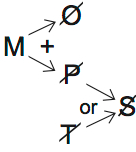
It’s a mistake to move on to the third rule if you don’t first combine the first rules like we just did.
The third rule mentions M, and M is already on the diagram, so you can connect the third rule like this:

That’s it! That one big diagram covers all the rules.
Learning how to draw it is one thing. You also need to know how to read it. You must read these diagrams left to right.
As an example: if W is in, then both Y and M must be in as well. Since M is in, O and P and S are out. We don’t know anything about T, it could be in or out. I’ve circled what we know, if W is in:
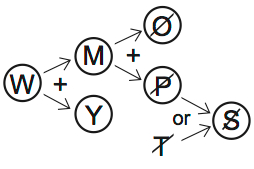
Let’s look at another example. What happens if P is out? We only know one thing: S is also out:
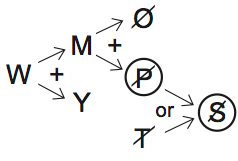
We don’t know anything about the other variables. Maybe M is in, or maybe it is out. P being out is just a necessary condition for M being out, so it doesn’t tell us anything about M.
The more you do these games, the more this type of diagram will make sense. It’s like learning a language, you can’t read them fluently at first. But once you can read this diagram, it’s by far the most powerful way to solve these games.
Now, we also need to take the contrapositive of the main diagram. You do this just like you’d take any other contrapositive:
- Reverse the order
- Negate everything
- Change ‘and’ to ‘or’, and vice versa.
Here it is:
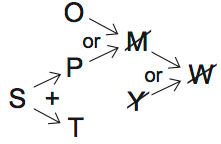
I highly recommend you draw this yourself on paper and practice the three steps. Taking contrapositives is a very mechanical process, which means it gets easy with practice.
There is one other rule that doesn’t fit on this diagram. At least four variables are selected. There could be more than four selected as well of course – four is just the minimum.
This rule was in the opening paragraph – you should always scan the opening paragraph to see if there’s any rules hidden in there.
Lastly, there are no rules for Z. A good way to represent this is to draw Z with a circle around it. I drew this near my other two diagrams.

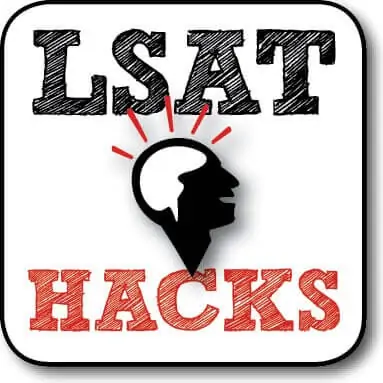
Want a free Logic Games lesson?
Get a free sample of the Logic Games Mastery Seminar. Learn tips for going faster at logic games

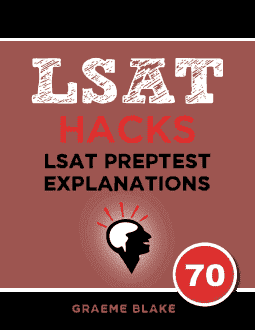
Hi Graeme,
Thank you so much for the explanations!
Roughly how long would you say this game should take?
I haven’t got a time estimate offhand unfortunately. And it’s hard to say. This game is harder than average, but if you learn the in/out game type you can go faster than average. I would redo it until you can do it in 5-7 minutes.
Can you suggest other in/out grouping games to practice? I find this type of game challenging.
For drilling, check out the following in/out grouping games:
1) PT58, S3, Game 2
2) PT59, S1, Game 3
3) PT61, S3, Game 3
4) PT34, S4, Game 4
I think you may have a mistake in final contrapositive. It should read O and P -> not M, not O or P -> not M.
The contrapositive of and is or. The original rule is M –> not O AND not P. So the contrapositive is or.